人教新目标(Go for it)版 七年级上 Unit 5 Do you have a soccer ball? Section A 词汇课件 (共18张PPT)
文档属性
| 名称 | 人教新目标(Go for it)版 七年级上 Unit 5 Do you have a soccer ball? Section A 词汇课件 (共18张PPT) | 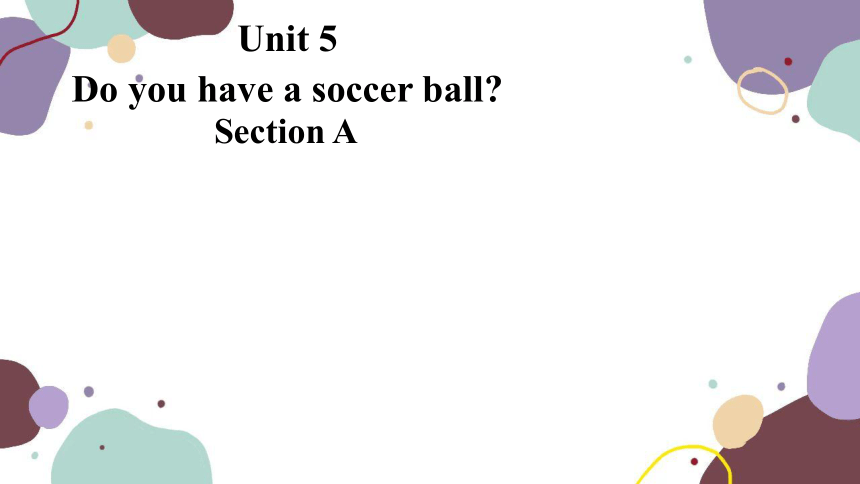 | |
| 格式 | pptx | ||
| 文件大小 | 1.6MB | ||
| 资源类型 | 教案 | ||
| 版本资源 | 人教新目标(Go for it)版 | ||
| 科目 | 英语 | ||
| 更新时间 | 2022-07-12 15:36:20 | ||
图片预览

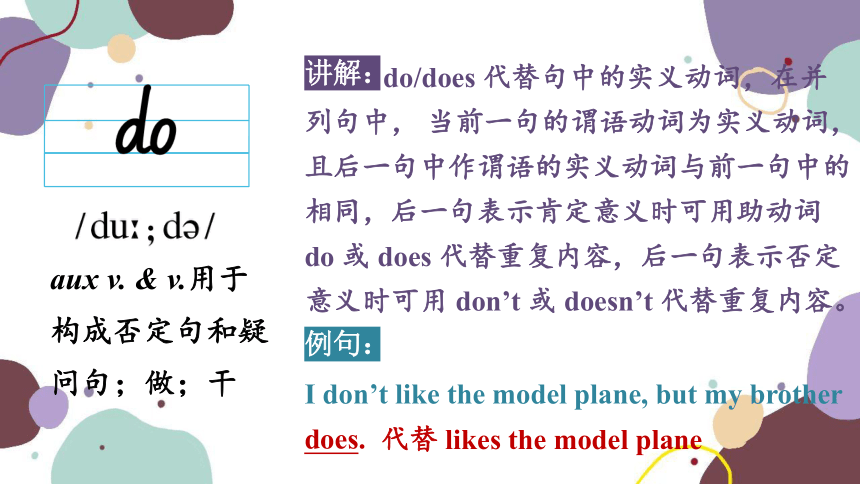

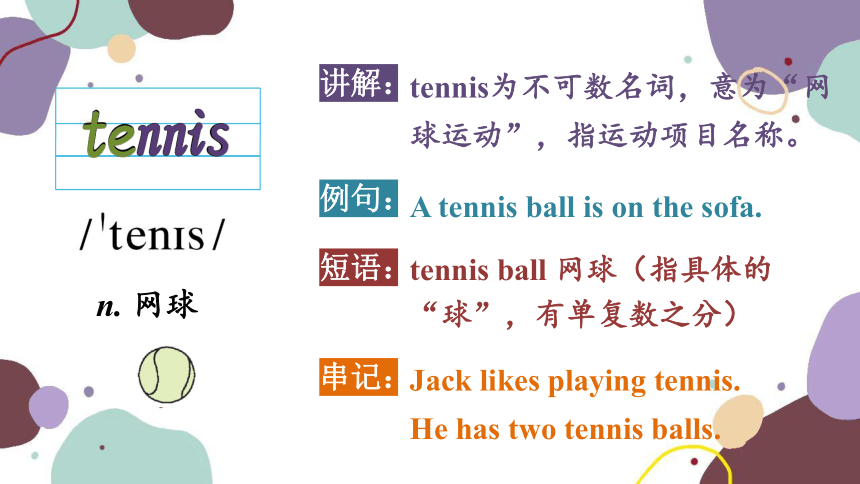
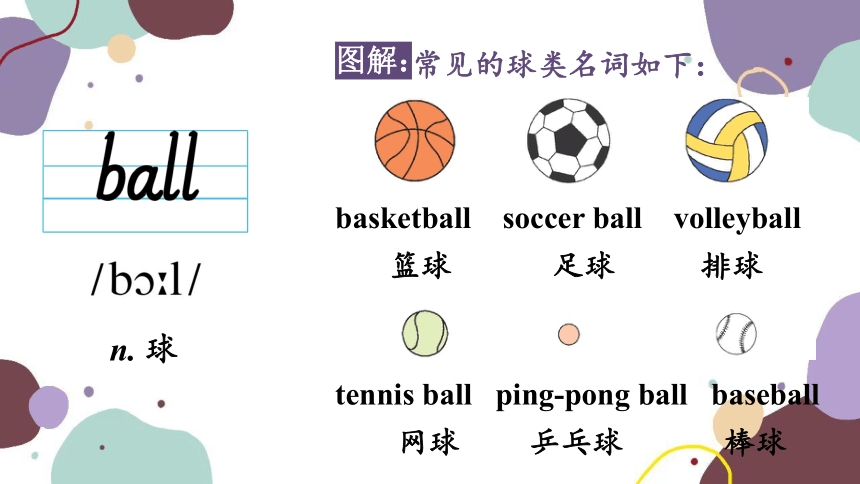
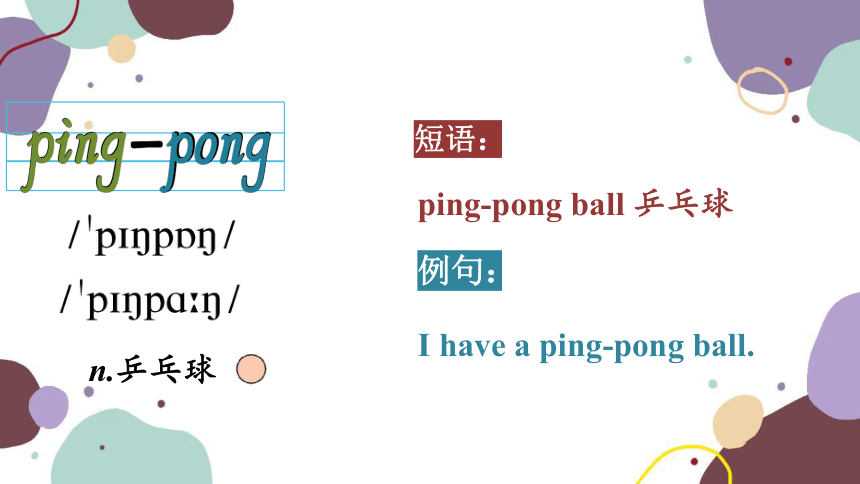
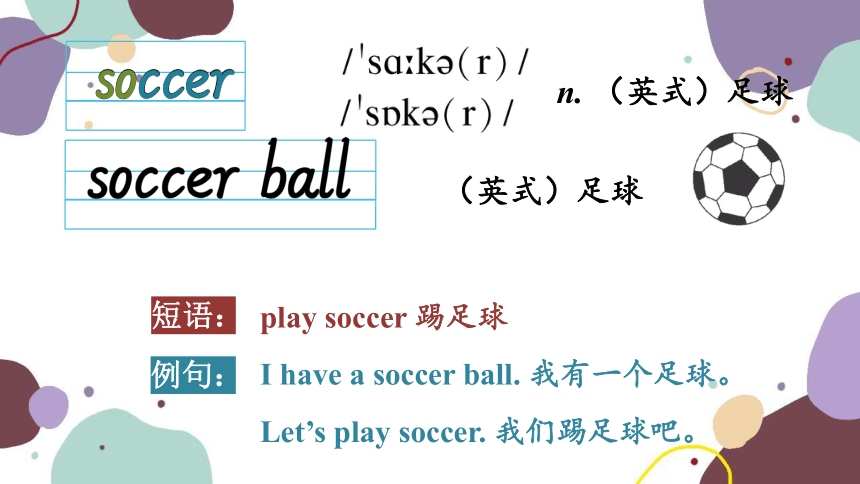
文档简介
(共18张PPT)
Unit 5
Do you have a soccer ball
Section A
aux v. & v.用于构成否定句和疑问句;做;干
例句:
I don’t like the model plane, but my brother does.
讲解:
do/does 代替句中的实义动词,在并列句中, 当前一句的谓语动词为实义动词,且后一句中作谓语的实义动词与前一句中的相同,后一句表示肯定意义时可用助动词 do 或 does 代替重复内容,后一句表示否定意义时可用 don’t 或 doesn’t 代替重复内容。
代替 likes the model plane
v. 有
讲解:
常用句式为“Sb. have/has…”,意为“某人有……”。
例句:
They have a good father.
He has a volleyball.
has 是 have 的第三人称单数形式
n. 网球
例句:
A tennis ball is on the sofa.
短语:
tennis ball 网球(指具体的“球”,有单复数之分)
讲解:
tennis为不可数名词,意为“网球运动”,指运动项目名称。
串记:
Jack likes playing tennis. He has two tennis balls.
n. 球
图解:
常见的球类名词如下:
basketball soccer ball volleyball
篮球 足球 排球
tennis ball ping-pong ball baseball
网球 乒乓球 棒球
n.乒乓球
例句:
I have a ping-pong ball.
短语:
ping-pong ball 乒乓球
n. (英式)足球
例句:
短语:
play soccer 踢足球
(英式)足球
Let’s play soccer. 我们踢足球吧。
I have a soccer ball. 我有一个足球。
n. 排球
例句:
She has a volleyball.
n. 篮球
例句:
David likes playing basketball.
v. 允许;让
讲解:使役动词
let sb. (not) do sth.
(sb.为人称代词时要用宾格形式)
让某人(不要)做某事
例句:
Let me help you.
Let Tom not play computer games.
pron. 我们
串记:
us 是人称代词 we 的宾格形式,一般放在谓语动词或介词之后作宾语。
例句:
Please help us.
Can you go to the school library with us
Can you help us We need your help.
讲解:
pron. 我们
辨析:
let’s
让我们(一起)
let’s 与 let us
图解:
包括此人
不包括此人
Let’s go!
Let us go!
let us
包括说话者和听话者
只包括说话者
Let’s say hello to him.
Let us go home!
v. 去;走
反义词:
I want to go to Beijing.
Jack always goes home at 5:30 in the afternoon.
come
例句:
短语:
go to+地点名词 去某地
讲解:
第三人称单数形式为 goes
当 go 后接地点副词 (home, here, there等) 时,要去掉介词to。
注意:
adj. 迟到
拓展:
Don’t get up late, Sally!
例句:
The boy is always late for school.
讲解:
early 早的
常在句中作表语
反义词:
短语:
be late for… ……迟到
adv. 迟地;晚地
例句:
v. (1)去取(或带来) (2)得到
讲解:
例句:
Please get me a ping-pong ball. = Please get a ping-pong ball for me.
Where do you get the basketball
get sb. sth. = get sth. for sb.
为某人去取某物
adj. 美妙的;伟大的
拓展:
可独立成句,常用于口语中,表达说话者的喜悦之情。
例句:
The model plane is great!
She is a great teacher.
讲解:
常在句中作表语或定语。
Great! 太好了!
例句:
—Let’s play volleyball!
—Great!
v. (1) 及物动词:参加(比赛或运动);(2)及物动词:弹奏;演奏;(3) 不及物动词:玩耍
讲解:
例句:
Can I play soccer with my friends now
(1) 其后常接球类或棋类名词,球类或棋类名词前不加冠词。
讲解:
例如:
play the piano play the guitar
(2) 其后常接乐器类名词,乐器类名词前要加定冠词 the。
讲解:
(3)
play with sb. 和某人玩耍
play with sth. 玩某物
v. 听起来好像
讲解:
例句:
—Lucy, how about going to the library
—Sounds great!
其后常接形容词作表语。
拓展:
n. 声音
例句:
It makes a nice sound.
Unit 5
Do you have a soccer ball
Section A
aux v. & v.用于构成否定句和疑问句;做;干
例句:
I don’t like the model plane, but my brother does.
讲解:
do/does 代替句中的实义动词,在并列句中, 当前一句的谓语动词为实义动词,且后一句中作谓语的实义动词与前一句中的相同,后一句表示肯定意义时可用助动词 do 或 does 代替重复内容,后一句表示否定意义时可用 don’t 或 doesn’t 代替重复内容。
代替 likes the model plane
v. 有
讲解:
常用句式为“Sb. have/has…”,意为“某人有……”。
例句:
They have a good father.
He has a volleyball.
has 是 have 的第三人称单数形式
n. 网球
例句:
A tennis ball is on the sofa.
短语:
tennis ball 网球(指具体的“球”,有单复数之分)
讲解:
tennis为不可数名词,意为“网球运动”,指运动项目名称。
串记:
Jack likes playing tennis. He has two tennis balls.
n. 球
图解:
常见的球类名词如下:
basketball soccer ball volleyball
篮球 足球 排球
tennis ball ping-pong ball baseball
网球 乒乓球 棒球
n.乒乓球
例句:
I have a ping-pong ball.
短语:
ping-pong ball 乒乓球
n. (英式)足球
例句:
短语:
play soccer 踢足球
(英式)足球
Let’s play soccer. 我们踢足球吧。
I have a soccer ball. 我有一个足球。
n. 排球
例句:
She has a volleyball.
n. 篮球
例句:
David likes playing basketball.
v. 允许;让
讲解:使役动词
let sb. (not) do sth.
(sb.为人称代词时要用宾格形式)
让某人(不要)做某事
例句:
Let me help you.
Let Tom not play computer games.
pron. 我们
串记:
us 是人称代词 we 的宾格形式,一般放在谓语动词或介词之后作宾语。
例句:
Please help us.
Can you go to the school library with us
Can you help us We need your help.
讲解:
pron. 我们
辨析:
let’s
让我们(一起)
let’s 与 let us
图解:
包括此人
不包括此人
Let’s go!
Let us go!
let us
包括说话者和听话者
只包括说话者
Let’s say hello to him.
Let us go home!
v. 去;走
反义词:
I want to go to Beijing.
Jack always goes home at 5:30 in the afternoon.
come
例句:
短语:
go to+地点名词 去某地
讲解:
第三人称单数形式为 goes
当 go 后接地点副词 (home, here, there等) 时,要去掉介词to。
注意:
adj. 迟到
拓展:
Don’t get up late, Sally!
例句:
The boy is always late for school.
讲解:
early 早的
常在句中作表语
反义词:
短语:
be late for… ……迟到
adv. 迟地;晚地
例句:
v. (1)去取(或带来) (2)得到
讲解:
例句:
Please get me a ping-pong ball. = Please get a ping-pong ball for me.
Where do you get the basketball
get sb. sth. = get sth. for sb.
为某人去取某物
adj. 美妙的;伟大的
拓展:
可独立成句,常用于口语中,表达说话者的喜悦之情。
例句:
The model plane is great!
She is a great teacher.
讲解:
常在句中作表语或定语。
Great! 太好了!
例句:
—Let’s play volleyball!
—Great!
v. (1) 及物动词:参加(比赛或运动);(2)及物动词:弹奏;演奏;(3) 不及物动词:玩耍
讲解:
例句:
Can I play soccer with my friends now
(1) 其后常接球类或棋类名词,球类或棋类名词前不加冠词。
讲解:
例如:
play the piano play the guitar
(2) 其后常接乐器类名词,乐器类名词前要加定冠词 the。
讲解:
(3)
play with sb. 和某人玩耍
play with sth. 玩某物
v. 听起来好像
讲解:
例句:
—Lucy, how about going to the library
—Sounds great!
其后常接形容词作表语。
拓展:
n. 声音
例句:
It makes a nice sound.
同课章节目录
- starters 预备篇(2012秋审查)
- Unit 1 Good morning !
- Unit 2 What’s this in English?
- Unit 3 What color is it ?
- Unit 1 My name's Gina.
- Section A
- Section B
- Unit 2 This is my sister.
- Section A
- Section B
- Unit 3 Is this your pencil?
- Section A
- Section B
- Unit 4 Where's my schoolbag?
- Section A
- Section B
- Unit 5 Do you have a soccer ball?
- Section A
- Section B
- Unit 6 Do you like bananas?
- Section A
- Section B
- Unit 7 How much are these socks?
- Section A
- Section B
- Unit 8 When is your birthday?
- Section A
- Section B
- Unit 9 My favorite subject is science.
- Section A
- Section B
